Alan Cathcart | June 18, 2019
Here’s the most powerful nakedbike ever conceived, the 2020 MV Agusta Brutale 1000 Prototype. The year 2020 is set to be a big one for MV Agusta.
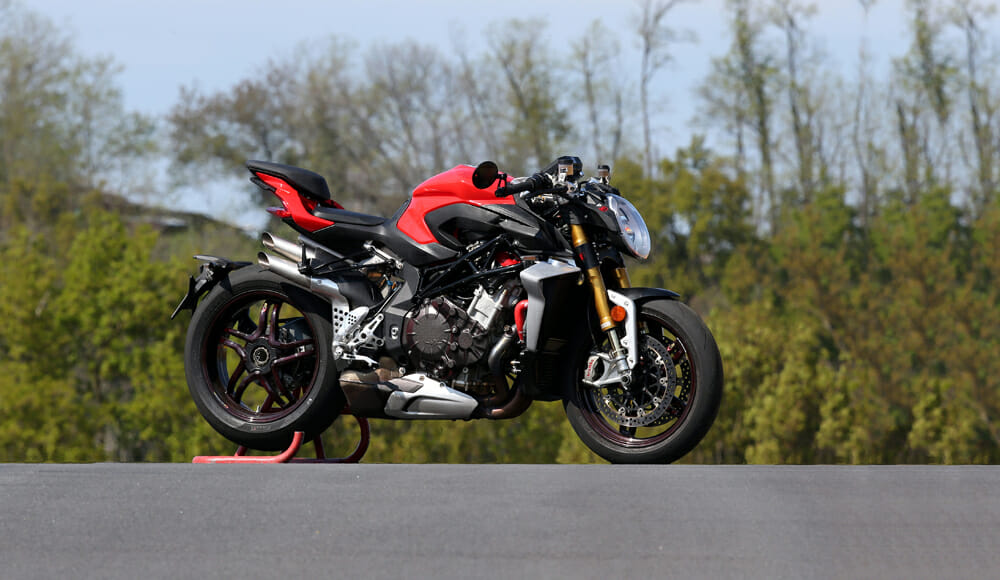 This MV uses every ounce of experience MV Agusta learned in WorldSBK. It’s an absolute beast.
This MV uses every ounce of experience MV Agusta learned in WorldSBK. It’s an absolute beast.
At the EICMA Milan Show last November, the dazzling new MV Agusta Brutale 1000 Serie Oro was elected as “The most beautiful motorcycle of the show” by over 16,000 voters—against such equally new high-performance desirables as the Ducati Panigale V4 R, the BMW S 1000 RR and Aprilia’s RSV4 1100 Factory.
Production of the new Brutale won’t commence until late August after MV workers return from this year’s summer break, but with Russian investor Timur Sardarov injecting over Euro 60 million to buy a controlling percentage in MV Agusta’s holding company from previous owner Giovanni Castiglioni (who remains President of the firm, with Sardarov as Chairman/CEO, and former Ducati technical guru Massimo Bordi returning to MV as a consultant), the Italian trophy marque finally has wind in its sails.
It has a slew of ultra-desirable new models on their way to production within the next 12 months, with the radically re-engineered Brutale 1000 up first, followed by the F4 Claudio and the Superveloce 800 all displayed at EICMA 2018, and other projects in the pipeline, including a turbocharged triple and the resurgence of the Cagiva brand as MV’s electric division.
The chance to visit the MV factory on the shores of Lake Varese to become the first outsider to sample the prototype next-gen Brutale 1000 lifted the curtain on what MV has in store for us under Sardarov’s direction—and it seems to be worth waiting for….
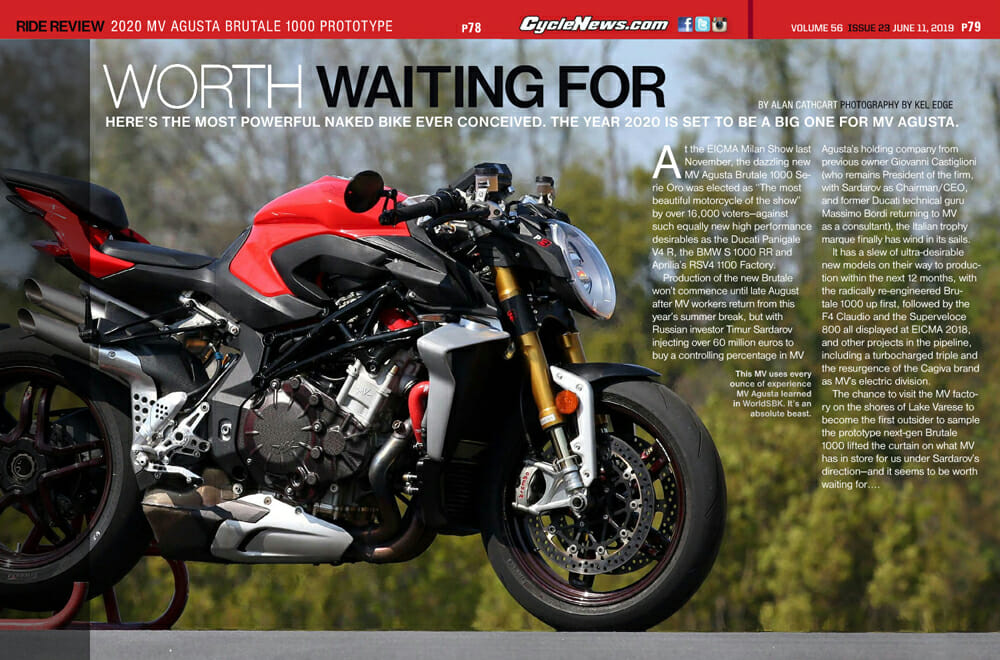
Photography by Kel Edge
But first, the price…
The first 300 examples of the Brutale 1000 will be the high-end limited-edition Serie Oro version costing €42,990 in Italy ($48,530), deliveries of which will commence in September as a 2020 model, available only in a single fire red color scheme.
Once those are built, production will begin of the Normale RR version—but don’t expect much change out of €30,000 ($33,870) for one of those, says MV’s Direttore Tecnico Brian Gillen, who heads up the 21-strong team of engineers in Varese charged with developing all the company’s new models, alongside the comparable workforce at the CRC design studio in San Marino, led by MV’s Design Director, Adrian Morton, where the bike was conceived and styled. “We’re still defining the exact specification of the RR version in order to get that into the price point where we want it to be,” says Gillen. “But it will have the same exceptional performance as the Serie Oro, as well as key technical elements like the Öhlins electronic suspension. Dynamically, they’ll be almost identical. But in both cases, there will be zero carryover parts from the previous 1090RR Brutale—even the 20 percent of common components like the crankcases and gearbox have been substantially modified on the new model.”
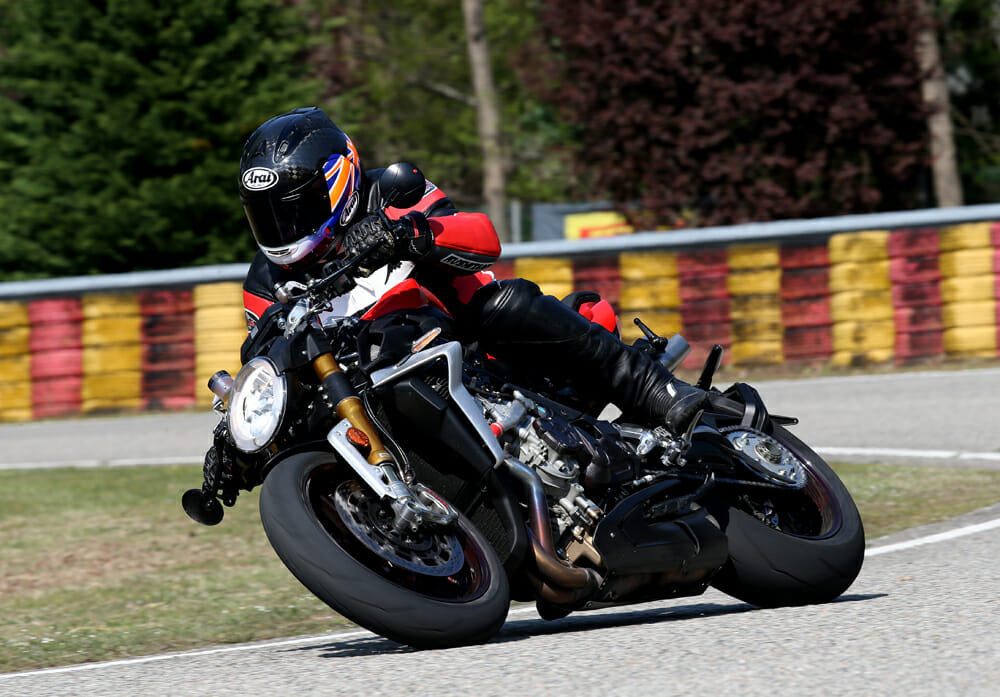 The next-gen electronic Ӧhlins suspension helps the MV corner like nobody’s business.
The next-gen electronic Ӧhlins suspension helps the MV corner like nobody’s business.
Testing the 2020 MV Agusta Brutale 1000
The opportunity to test the Brutale 1000 in pre-production form came at the Pirelli test track at Vizzola, about 20 miles from the MV factory. Not being an MV employee, I wasn’t allowed out on the highway with the Prova plate the unregistered bike was carrying. Anyway, that’s where much of the R&D testing of the new model has been done, with the Italian tire company’s latest and greatest Diablo Supercorsa III rubber naturally fitted to the BST carbon fiber wheels that are standard on the Brutale Serie Oro.
These come complete with an improbable red weave inside the material the wheels are made from that shimmers in the sunshine—a technical step forward by the South African manufacturer that brings added bling to the Brutale, and helps justify all those zeros on its price tag.
Equally admirable is the way that Adrian Morton has so successfully captured the stylistic spirit of Massimo Tamburini’s original mind-blowing Brutale design (which Adrian had a hand in creating) unveiled two decades ago at the 2000 Intermot Show in Germany, but once again in a context that’s bang up-to-date. The result is an accomplished piece of two-wheeled design theatre complete with the Brutale’s trademark quad exhaust outlets—the Tamburini organ has become the Morton harmonium, but without losing its dramatic appearance, or its haunting howl at high speed. It’s just a bit more muted now, with Euro 4 compliant silencing.
But after tiptoeing aboard the 33.2-in high seat, I discovered a riding stance that’s surprisingly well balanced, without excessive weight on my arms and shoulders, even though the quite flat spread of the sportbike-style ’bars bolted to the top of the fork legs delivers an inherently inclined wind-cheating posture, with my knees rucked neatly into the sculpted recesses of the 5-gal fuel tank. The new Brutale is improbably comfortable for this fast a bike.
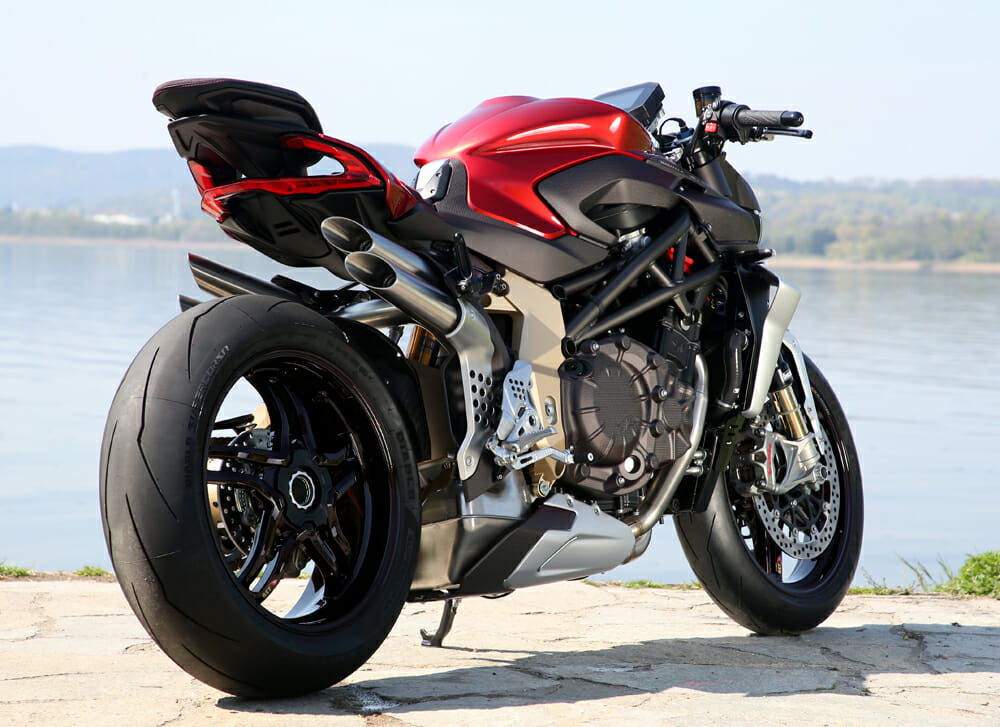 Isn’t that one of the most stunning back-ends you’ve ever seen?
Isn’t that one of the most stunning back-ends you’ve ever seen?
And objective of speed
And fast it is—very, very fast, so much so in fact that the massive Pista Pirelli complex’s 2600 ft- main straight proved to be too short for me to really rev the new Brutale out in top gear—the best I saw was 233km/h (144mph) in fourth from a rolling start, with 13,000 rpm showing on the well-designed five-inch TFT dash that’s light years better than the small, crowded and mostly illegible previous instrument that MV always fitted. But at that speed the new Brutale stayed totally planted on the asphalt, thanks to the radiator shroud that was added after Gillen’s R&D team encountered an ‘interesting’ problem in early testing.
“When we rode the bike for the first time, we discovered that we had the rider completely in the wrong spot,” says Brian with a grimace. “From 278 km/h up it was trying to wheelie backwards, so we had to completely rethink where we were putting the rider on the bike, and how we could hold the front wheel down. We realized we needed to incorporate wings into the design—but it’s a naked bike, with minimal bodywork, so how do you do that? But Adrian Morton did another design iteration which very successfully integrated the wings into the radiator surround, and we went to a wind tunnel in Perugia where we found we now have 15kg (33 lb) of downforce on the front wheel at 300 km/h—and sixth gear wheelies are a thing of the past!”
Well, I couldn’t test that at the Pirelli track, but I could sample the absolutely phenomenal acceleration the Brutale now delivers. Flexible and forgiving low down, it was perfectly happy to be short-shifted at around 6,000 rpm in an imitation of real world riding round a tight street simulation section of track, but show it a stretch of open road, and it just rockets away from a standing start, albeit with the front wheel pawing the air since the anti-wheelie software wasn’t functioning on the test bike.
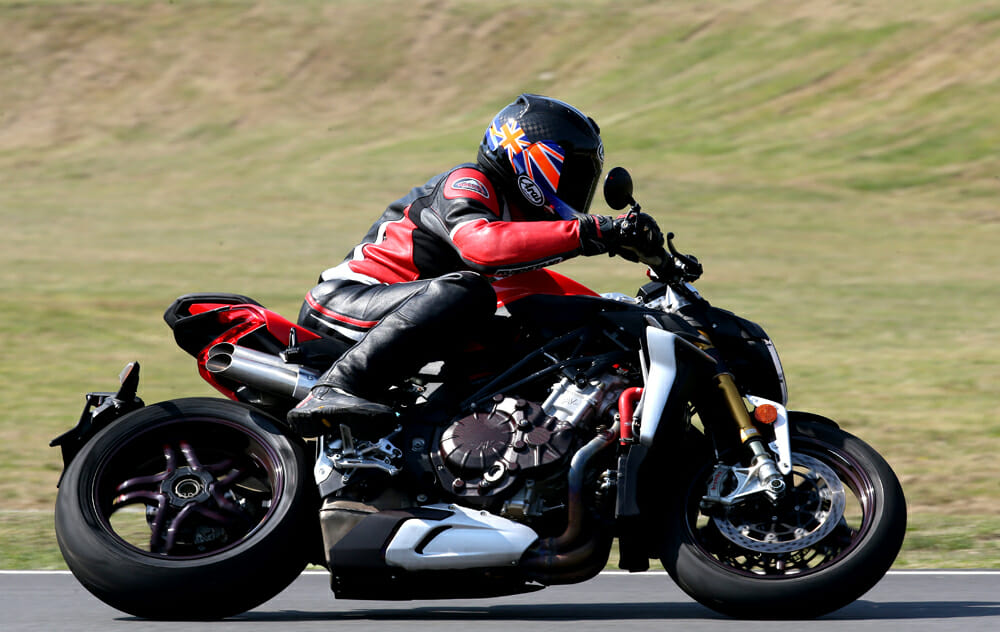 Has MV just created the ultimate naked bike? Alan certainly thinks so.
Has MV just created the ultimate naked bike? Alan certainly thinks so.
Still, despite stamping on the rear brake pedal to try to hold the front wheel down, it motors so very hard, though you must tense yourself to hold on tight as the MV lunges forward like a guided missile. The two-way powershifter is brilliantly set up, as befits the company which has a longer experience of fitting this to their roadbikes than anyone else. It’s not too sensitive, so you must do more than just brush your boot against the lever and need to make a decisive movement, but the cutout is infinitesimal in duration, and the gearshift completely seamless in nature in both directions. You do feel a step in the power delivery at 9,500 rpm, just after torque has peaked, when it seems the acceleration kicks in even harder. This is unbelievably exhilarating to experience—yet all achieved with minimal vibration at any revs, thanks to the effective gear-driven counterbalancer installed.
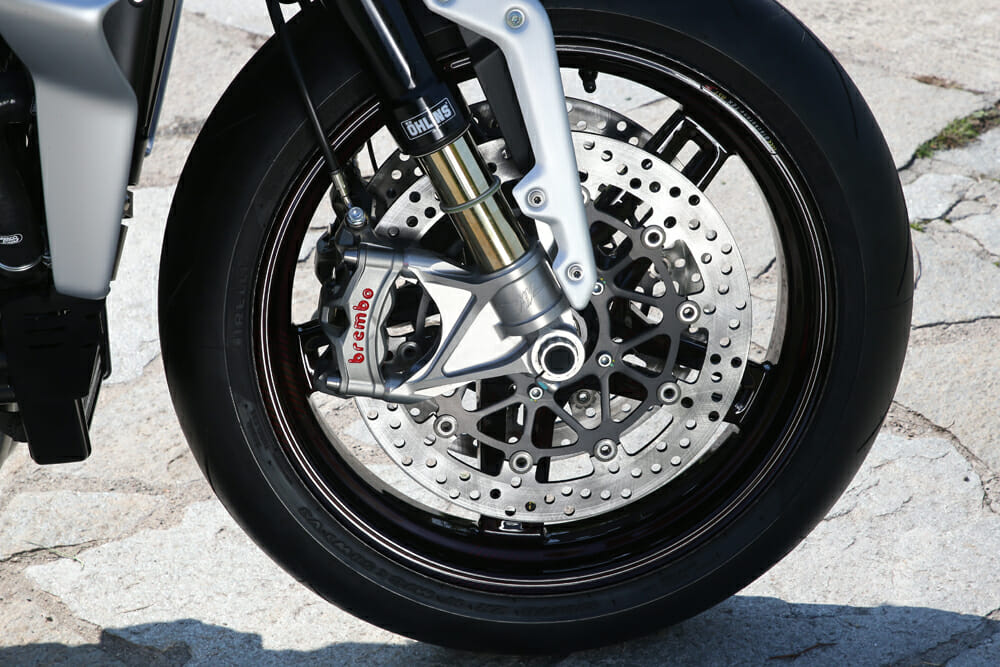 Brembo has fitted their latest Stylema calipers in the same fashion as the Ducati Panigale V4 R and the Aprilia RSV4 1100 Factory.
Brembo has fitted their latest Stylema calipers in the same fashion as the Ducati Panigale V4 R and the Aprilia RSV4 1100 Factory.
Finesse to match the power
So, powering through the gears and shifting at 14,000 rpm delivers warp factor acceleration—but the Brutale goes round corners well, too, and in some ways this was the most impressive aspect of the new bike’s development. I’ve ridden the factory F4 Superbike in the form it was in when Leon Camier took it over, and let’s just say he had work to do to make it remotely competitive, because it steered like a truck—heavy and hard to change direction with, and seemingly unpredictable in the way it fell on its side into turns. That he and Gillen’s technical team succeeded in redressing that was proved by the bike’s race results in Leon’s hands—and the benefits of that development have been incorporated in the new Brutale.
This now handles in an improbably agile manner for such a powerful and frankly meaty motorcycle—and it’s forgiving, too. You can make an error of judgement with your turn speed halfway round a bend, finger the front brake lever to cram off a little speed, and the Brutale just slows, without sitting up and heading for the hedges—or the yellow and red painted tires lining the Pirelli test track.
Yet get your judgement right, and it sails round turns one gear higher than you might have expected, the front Pirelli glued to the track surface, and the Öhlins suspension working in perfect concert. The engine mapping is ideal in both Sport and Race modes, and though throttle response is notably more aggressive in the latter, pickup from a closed throttle is strong rather than snatchy, and you feel a sense of control that’s very welcome with such a potent performance package.
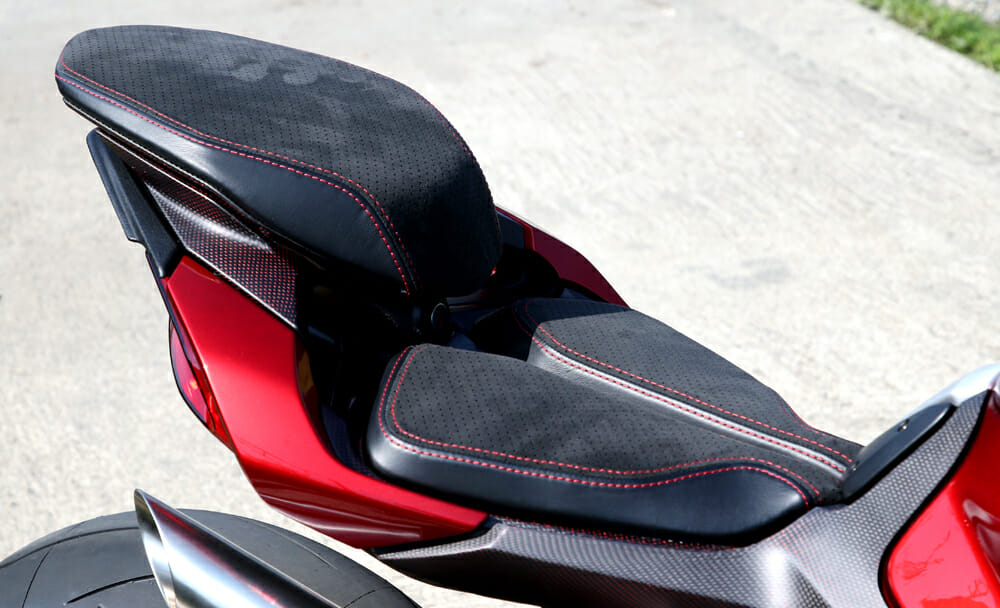 Comfort is surprisingly good for something so racy.
Comfort is surprisingly good for something so racy.
MV boss Timur Sardarov’s objective of delivering a high level of performance that’s satisfying but not scary has been achieved. Then, at the end of the straight I could haul the speed down from 140 mph for the second-gear hairpin with total confidence—the Brembo Stylema calipers have even better feel and feedback than before. And the Bosch ABS did its job in minimizing rear wheel lift even with my body weight thrown forward onto the front wheel under that awesome stopping power, with the engine braking control still retaining some welcome assistance via the all-new slipper clutch now fitted as I backed down the gears seamlessly and clutchlessly.
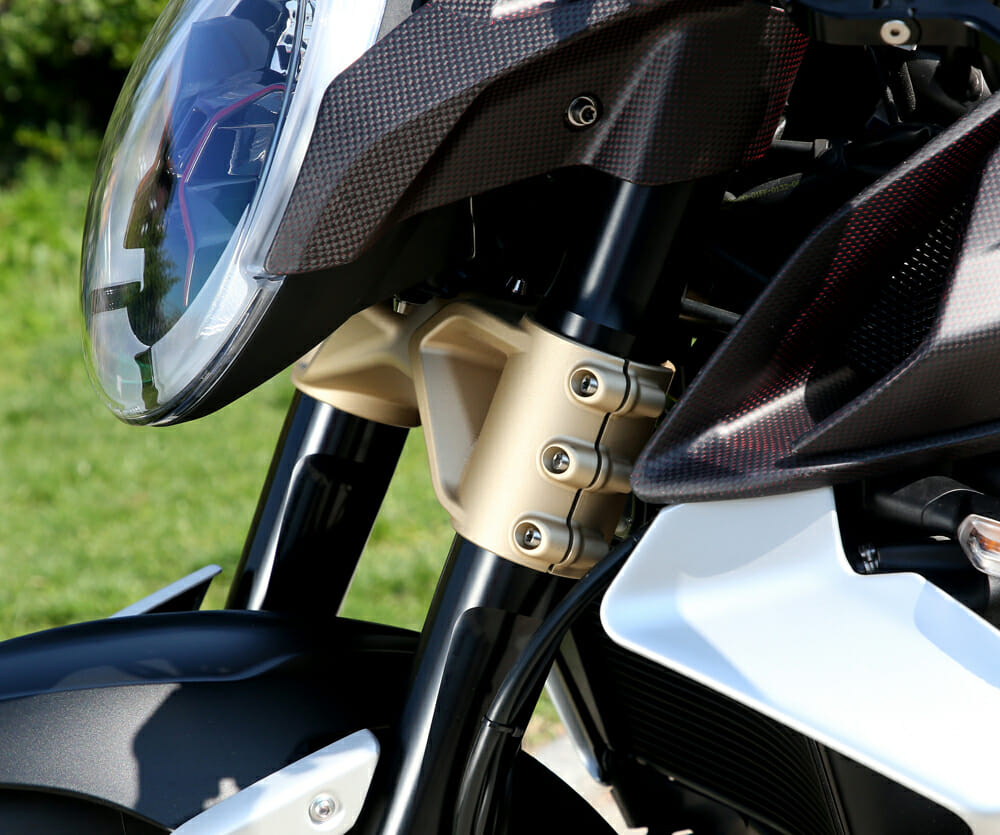 Everywhere you look, there are beautiful touches. Check out this gold triple clamp and the red weave in the carbon fiber.
Everywhere you look, there are beautiful touches. Check out this gold triple clamp and the red weave in the carbon fiber.
You want one
Dripping with desirability, the new Brutale 1000 Serie Oro is an enticing combination of matchless performance by naked bike standards, coupled with peerless handling and arresting good looks that come stamped with the Brutale trademark. Adrian Morton and his team have achieved that most difficult of tasks in reinventing a design icon, while retaining its unmistakable looks and unique heritage—and in so doing, have restored MV Agusta to its previous pedestal as the maker of the most alluring and enticing high-performance motorcycles money can buy.
But Brian Gillen and his men have achieved an equally difficult task, in substantially revamping a two-decade old engine, in successful pursuit of a new level of performance that other manufacturers will find it hard to match. It’s a job well done by all concerned, which those who voted for it in the EICMA 2018 beauty poll evidently understood. Timur Sardarov will be hoping that he can find sufficient customers prepared to vote for the new bike in production ready form – but this time with their credit cards.
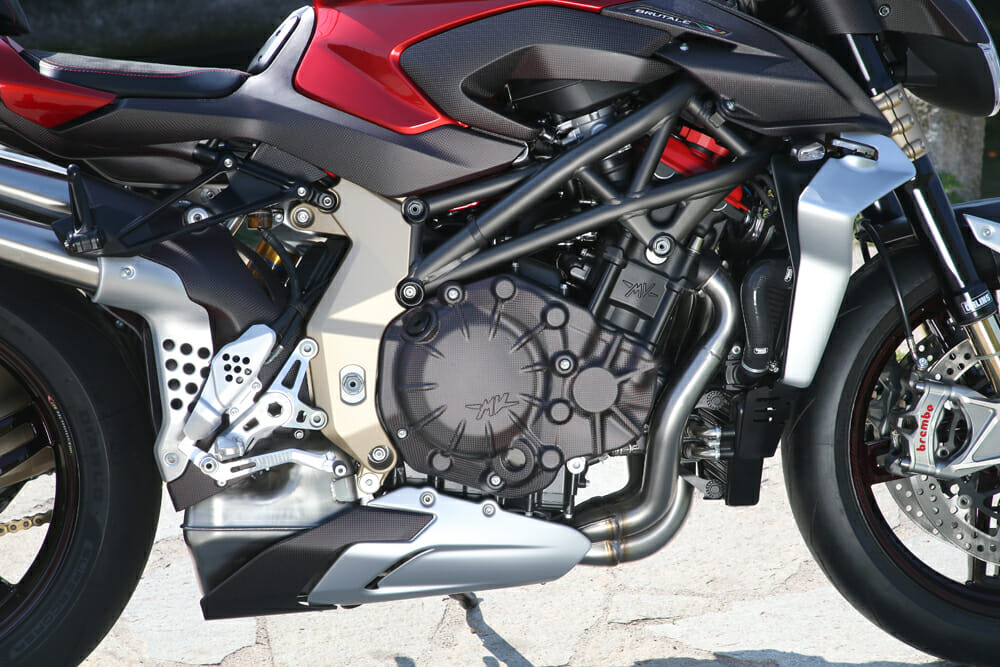 208 hp on tap. In a naked-bike motor. Wow.
208 hp on tap. In a naked-bike motor. Wow.
You want fast? How’s this for fast…
A homologated top speed of 188 mph sound—from a naked bike—is very, very impressive. That’s thanks to the 208bhp produced at 13,450 rpm at the crankshaft by the new Brutale’s heavily revised version of the previous F4 Superbike inline-four motor—yet with 84.81 lb-ft of torque delivered at just 9,300 rpm, so with a 4,000 rpm span between peak torque and peak power, it promises to be a pretty rideable motorcycle, too. (An optional RC-Project titanium exhaust system extracts 212 hp at 13,600 rpm, but isn’t Euro 4 compliant.)
These impressive numbers come courtesy of what’s essentially an all-new motor that’s safe to a 14,200 rpm limiter, and has been designed with a focus on reducing friction and enhancing lubrication. Add in a claimed dry weight of 410 lb thanks partly to copious magnesium covers and titanium bolts, screws and fasteners, as well as carbon-fibre bodywork—such as it is—and on paper at least the 2020-model Brutale 1000 threatens to be a new performance benchmark for the Naked Roadster category.
As such, it challenges the current dominance of the 405 lb Aprilia Tuono V4 1100 that narrowly out-muscles the MV in making 88.5 lb-ft of torque at 9,000 revs, but comes up short in the horsepower stakes, with a ‘mere’ 175bhp at 11,000 rpm. Well, everything’s relative…
Paradoxically, though, at a time when other manufacturers are increasing capacity of their engines (Aprilia and Ducati being the most recent and obvious such examples) to redress the effects of such regulatory hurdles as Euro 4, MV Agusta is travelling in the opposite direction, versus the 1078cc displacement of the its previous range-topping Brutale 1090RR, production of which ended a couple of years ago, without Euro 4 compliance. “You can obtain more power in one of two ways – either with greater displacement, or with extra revs,” says Brian Gillen. “But with displacement we’d have had to go even bigger than 1078cc, if we really wanted to get what we were looking for from a performance standpoint. So we chose instead to go with a smaller displacement, but with a higher revving motor—and the result is considerably more horsepower.”
That new smaller displacement uses the same 79mm bore as before, but with the stroke shortened from 55mm to 50.9mm to measure 998cc. This reflects MV’s objective in redesigning the engine, which is basically to productionize what the next generation F4 Superbike engine would have been.
Old thinking meets modern design
Work began just over two years ago on the Brutale’s new in-line four-cylinder engine, which retains the same crankcases as before, but machined differently to incorporate an uprated lubrication system aimed at countering oil surge under the massively enhanced acceleration of the new bike. This delivers over 1G when the launch control button on the right handlebar is pressed, says Gillen, en-route to an official 2.9sec 0-100km/h trap time—with lights and a horn, and Euro 4 compliance. Phew!
Essentially, what the R&D team has done is to copy the format of Mike Hailwood’s 1960’s MV Agusta World champion 500GP four, and created an oil reservoir beneath the crankcase. This results in a semi-dry sump engine with reduced oil drag, while at the same time positioning a splitter within the casing to minimize surge, and stop the oil rushing to the back of the crankcase under hard acceleration. “Motorcycle physics haven’t changed from the 1960s up to today,” says Gillen. “We simply reapplied the technology from back then, in a modern context.”
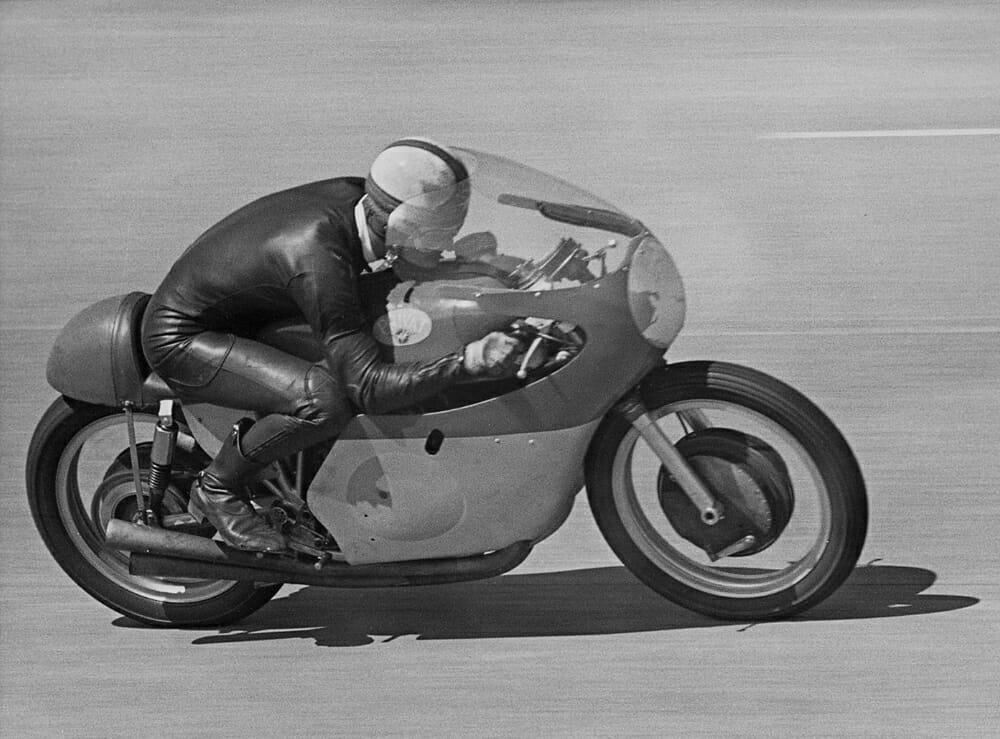 Mike “The Bike” Hailwood on the MV Agusta 500 in the early 1960s. The thinking on motorcycle design hasn’t changed much since then.
Mike “The Bike” Hailwood on the MV Agusta 500 in the early 1960s. The thinking on motorcycle design hasn’t changed much since then.
The modified shorter-stroke crankshaft has altered lubrication channels and all-new bearings, and carries new forged titanium conrods (rather than machined from billet, so even stronger and lighter) made by Oral Engineering in Modena, headed by former Ferrari F1 technical boss Mauro Forghieri. These carry forged three-ring Asso pistons with cast-iron compression rings aimed at reducing friction. The F4 cylinder head casting has been retained, still with radial valves, but with quite different intake porting and new chain-driven camshafts delivering greater lift and dwell. Additionally, the combustion chambers housing the 31.8mm intake and 26.5mm radial valves have now been machined from solid billet, to deliver a high 13.6:1 compression ratio—the previous Brutale was 12.8:1—a key element in obtaining the radically enhanced acceleration which Gillen targeted.
Electronics and dimensions
The new Brutale 1000 features a key upgrade with the installation of a much-needed RBW/ride-by-wire throttle absent from its predecessor, here incorporating four riding modes regulated by an IMU inertial platform—Race, Sport, Rain and Custom—which can be selected on the go without closing the throttle, and a much more sophisticated electronic package.
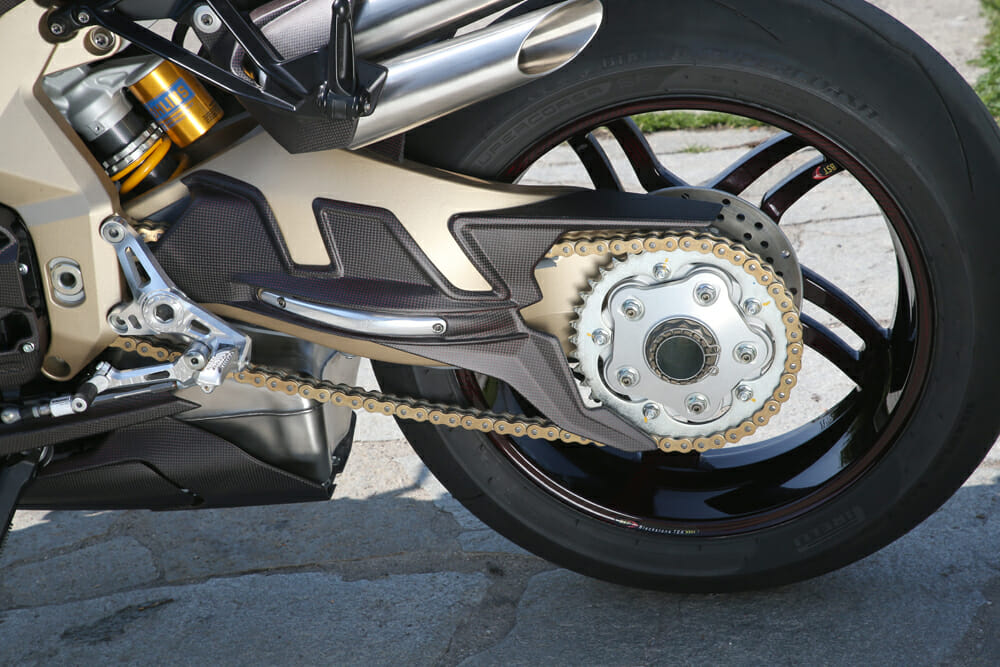 The single-sided swingarm carried in an adjustable pivot is a direct carry-over from the previous model.
The single-sided swingarm carried in an adjustable pivot is a direct carry-over from the previous model.
This includes eight-level TC/traction control, engine braking control, on/off anti-wheelie control, and a two-way power shifter (which MV was the first to fit to a production motorcycle five years ago). But this has involved choosing the specific optimum supplier for each element, then splicing them together under MV’s direction, says Gillen—so the RBW system with a quartet of 50mm throttle bodies is by Mikuni, which also supplies the lower of the two injectors per cylinder, with the upper top-spray injectors from Magneti Marelli.
But MV’s traditional partner Eldor supplies the ECU, with two of its engineers permanently working on the MV dyno to perfect the mapping, while switchable Bosch 9 Plus Race Mode Cornering ABS is installed, with RLM (rear wheel lift) control incorporated.
Moreover, Öhlins latest-gen semi-active electronic suspension is fitted front and rear to vary damping automatically according to road and riding conditions, with both the 43mm NIX fork and TTX rear shock delivering 120mm of travel via electronically controlled compression and rebound damping, and also spring preload on the shock (manual adjustment on the fork). The damping map also changes according to the rider mode selected, so for example Race has a quite different suspension response than Rain. The Öhlins steering damper is also electronically controlled, but this time it’s simply velocity adjustable—so it’s lighter at low speeds in town, automatically becoming progressively stiffer as speed rises up to the 180 mph mark.
This electro-suspension adorns a redesigned version of MV’s usual composite chassis, with a chrome-moly tubular steel trellis frame combined with twin aluminum side plates, in which the engine is carried as a fully stressed member. This delivers a 56.3 in. wheelbase with the fork sitting at a 24° rake with 3.8 in. of trail.
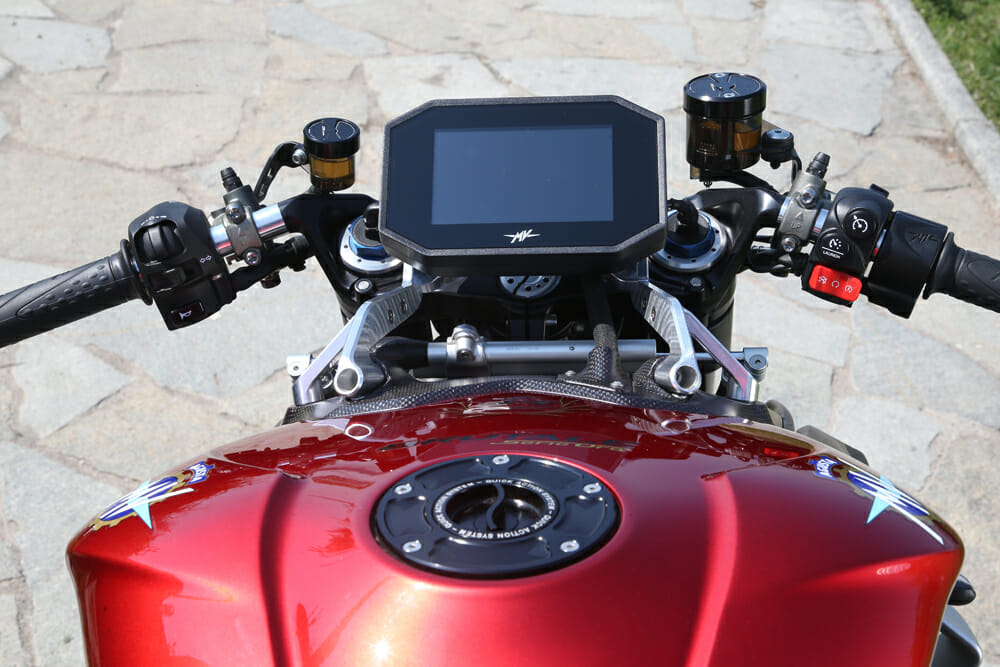 The dash is substantially improved compared to MVs of old.
The dash is substantially improved compared to MVs of old.
The single-sided swingarm carried in an adjustable pivot is a direct carry-over from the previous model, says Brian Gillen, and is still cast in aluminum, rather than magnesium. Brembo’s new range-topping Stilema four-piston Monoblock brake calipers are fitted up front, paired with 320mm floating discs, with a twin-piston Brembo and 220mm rear disc combo.
However, one electronic system that has at first sight surprisingly been removed from the new Brutale 1000 is the TSS variable length intake system, which MV Agusta says was made redundant after it produced too much usable torque and added an extra 3.5 lb weight.CN
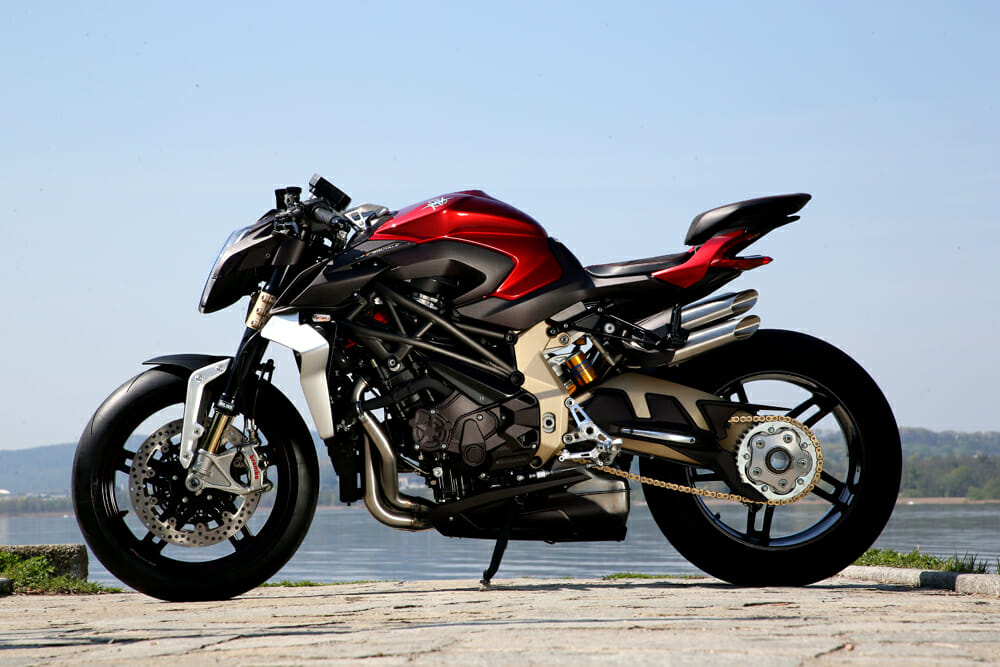
2020 MV Agusta Brutale 1000 Prototype Specifications
| Engine: |
DOHC, four-valve, inline, four-cylinder |
| Displacement: |
998cc |
| Bore x stroke: |
79 x 50.9 mm |
| Compression ratio: |
13.65:1 |
| Fuel system: |
EFI |
| Power: |
208 hp at 13,450 rpm |
| Torque: |
84.8 lb-ft at 9300 rpm |
| Exhaust: |
4-2-3 |
| Clutch: |
Wet multi-plate |
| Transmission: |
6 speed |
| Chassis: |
Steel tubular trellis |
| Front suspension: |
43mm Öhlins Nix EC hydraulic upside down forks with TiN treatment. Adjustable with electronically controlled compression and rebound damping with manually controlled spring preload, 4.7 in. wheel travel |
| Rear suspension: |
Progressive, single shock absorber Öhlins TTX. Adjustable with electronically controlled compression and rebound damping and spring preload, 4.7 in. wheel travel |
| Front brake: |
Dual 320mm discs, dual four-piston Brembo Stylema Monobloc calipers, Bosch Cornering ABS |
| Rear brake: |
220 mm disc, single-piston caliper with Bosch Cornering ABS |
| Front wheel: |
Carbon fiber 3.50 x 17 in. |
| Rear wheel: |
Carbon fiber 6.0 x 17 in. |
| Front tire: |
120/70 R17 |
| Rear tire: |
200/55 R17 |
| Wheelbase: |
56.3 in. |
| Seat height: |
33.2 in. |
| Fuel capacity: |
5 gal |
| Weight: |
410 lb (dry, claimed) |
| MSRP: |
TBA |